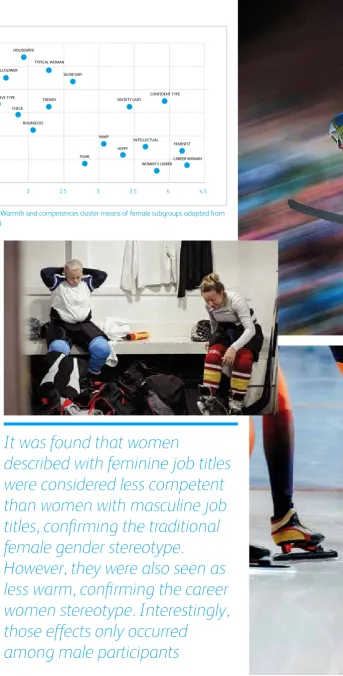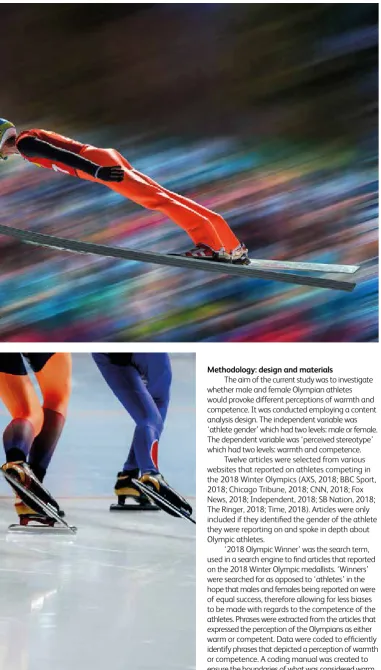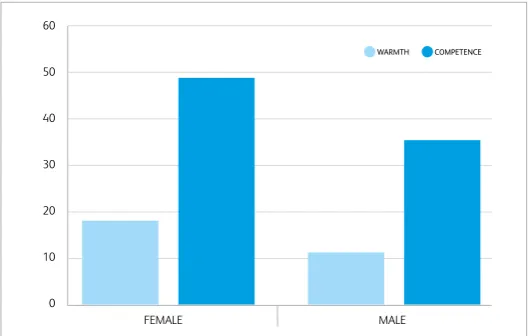OLYMPIC
REPRESENTATION
ur research indicates how, in contrast to traditional gender stereotypes, the portrayal of Olympic athletes in news articles shows female athletes to be just as competent as male athletes and male athletes to be just as warm as female athletes
What research says about traditional and non-traditional female stereotypes
Stereotypes can be described as prior conceptions or schemas that are shared in society about a group of people and includes the attributes that this group or a member of the group are believed to have. A social psychological theory, the Stereotype Content Model, suggests that stereotypes of all social groups are represented as a combination of the two dimensions of warmth and competence (Fiske, Cuddy, Glick & Xu 2002). Warmth is based on the perception of competitiveness; a lack of competitiveness predicts warmth, whereas a highly competitive person may be perceived as cold (Cuddy et al., 2009). Competence is predicted based on status with those high in status being perceived as more competent since status refers to the resources and prestige a group has acquired, whereas those low in status are considered to be less competent (Kervyn, Fiske and Yzerbyt, 2015).
Cuddy et al., (2009) argue that females are stereotyped as high in both competence and warmth whereas, Eckes (2002) has shown that this is not the case when women are divided into sub-groups (see Figure 1). In the Eckes study participants were presented with male or female subgroups and asked to rate their warmth and competence. It was found that women assuming traditional roles in society were a group perceived to be low in competence but high in warmth, congruent with paternalistic stereotypes and associated with an emotional response of ‘pity’. These types of groups tend to receive help rendering them as subordinate and they may also be scorned and socially avoided. Women that took on non-traditional roles (e.g. career women, athletes and feminists), however, were stereotyped as high in competence but low in warmth (similarly to males) – a stereotype that is associated with the emotional response of envy or resentment.
O
Women that took on non-traditional
roles (e.g. career women, athletes
and feminists), however, were
Research has also identified that when participants are encouraged to focus on women’s appearance, they rated women as less warm and less competent (Heflick, Goldenberg, Cooper & Puvia, 2011). They conducted a series of experiments in which participants were asked to watch videos or look at pictures of men and women of equal status. Participants were shown a picture/video of a woman or a man and were either asked to focus on the appearance of the person or not. When the focus was on appearance, women and not men, were perceived as less competent, warm and moral. This effect remained constant when familiarity, physical attractiveness and occupational status were controlled for. Heflick et al.’s study provided compelling experimental evidence that drawing attention to the appearance of the person being evaluated, caused a drop in the perception of warmth, competence and morality for women only – rendering them an objectified or dehumanised group under those circumstances.
In addition, when feminine nouns were included in job titles, it has been found that women were perceived as warmer than their male counterparts, but perceptions of competence were not effected (Merkel, Maass & Frommelt, 2012). Contrasting findings were presented by Budziszewska, Hansen and Milewicz (2014) who conducted a study in which participants rated women on warmth and competence, after either reading a scenario in which the woman had a traditionally feminine or masculine job title. It was found that women described with feminine job titles were considered less competent than women with masculine job titles, confirming the traditional female gender stereotype. However, they were also seen as less warm, confirming the career women stereotype as suggested by Eckes (2002). Interestingly, those effects only occurred among male participants.
As stated by Fiske (2002), female athletes are a sub-group of ‘non-traditional’ women, and therefore rate similarly to males as high in competence and low in warmth. However, as Olympic events tend to have the gender in the title (e.g. Men’s 4x100 Relay vs Women’s 4x100 Relay), it could be argued that the gender salience in the title will activate traditional gender stereotypes and cause females to be considered as less competent and more warm, as found by Eckes (2002) in relation to women assuming traditional roles.
In line with stereotypes found for non-traditional women, it was hypothesised that there would be no difference between male and female Olympic athletes in terms of their portrayal as warm or competent. The alternative hypothesis, in line with traditional gender stereotypes, was that male Olympian athletes would be depicted as higher in competence and female Olympian athletes would be depicted as higher in warmth.
It was found that women
described with feminine job titles
were considered less competent
than women with masculine job
titles, confirming the traditional
female gender stereotype.
However, they were also seen as
less warm, confirming the career
women stereotype. Interestingly,
those effects only occurred
among male participants
FIGURE 1: Warmth and competences cluster means of female subgroups adapted from Eckes (2002)
1.5 2 2.5 3 3.5 4 4.5 4
3.5
3
2.5
2
1.5
HOUSEWIFE TYPICAL WOMAN
SECRETARY TRENDY CHICK
BOURGEOIS
SOCIETY LADY VAMP PUNK
HIPPY INTELLECTUAL
FEMINIST CAREER WOMAN WOMEN’S LIBBER
CONFIDENT TYPE WALLFLOWER
Methodology: design and materials
The aim of the current study was to investigate whether male and female Olympian athletes would provoke different perceptions of warmth and competence. It was conducted employing a content analysis design. The independent variable was ‘athlete gender’ which had two levels: male or female. The dependent variable was ‘perceived stereotype’ which had two levels: warmth and competence.
Twelve articles were selected from various websites that reported on athletes competing in the 2018 Winter Olympics (AXS, 2018; BBC Sport, 2018; Chicago Tribune, 2018; CNN, 2018; Fox News, 2018; Independent, 2018; SB Nation, 2018; The Ringer, 2018; Time, 2018). Articles were only included if they identified the gender of the athlete they were reporting on and spoke in depth about Olympic athletes.
‘2018 Olympic Winner’ was the search term, used in a search engine to find articles that reported on the 2018 Winter Olympic medallists. ‘Winners’ were searched for as opposed to ‘athletes’ in the hope that males and females being reported on were of equal success, therefore allowing for less biases to be made with regards to the competence of the athletes. Phrases were extracted from the articles that expressed the perception of the Olympians as either warm or competent. Data were coded to efficiently identify phrases that depicted a perception of warmth or competence. A coding manual was created to ensure the boundaries of what was considered warm and competent were clear (e.g., warmth was depicted
by athletes demonstrating a lack of competitiveness and; competence was depicted by the writer considering the athlete high in status). Perceived competence was shown in many ways, an example of this was a complimentary comment about the athlete’s achievement (e.g. “She has transcended the boundaries of her sport”). Warmth could also be shown in many ways, one example of this was an athlete showing emotion at the outcome (e.g. “the team’s poor finish was Noh’s fault, Noh cried”).
Phrases were marked as ‘1’ for warmth or ‘2’ for competence, with phrases about females being marked as ‘1’ and phrases about males being marked as ‘2’. One-hundred-and-thirteen phrases were collected and entered into a coding schedule which was then transferred into SPSS to conduct a Chi Square 2x2 analysis and determine if there was an association between gender and perceived stereotypes of warmth and competence.
Results
The study hypothesised that males would have a higher number of phrases depicting them as competent and that females would have a higher number of phrases depicting them as warm compared to males. The collected data was entered into SPSS to conduct a 2x2 chi square analysis and the descriptive statistics are outlined in Table One.
Table 1 displays the frequencies of phrases depicting warmth and competence towards male and female Olympic athletes. More phrases representing warmth were found for female Olympian athletes than male athletes, with 18 phrases for females compared to 11 for males. Phrases indicating competence were also found to be in greater numbers for females than males, with 49 phrases for females compared to 35 for males.
In addition, far less phrases were found to signal warmth than competence. 29 phrases were found for warmth, whereas 84 were found to demonstrate competence.
This data shows that females were considered as warmer and more competent than males in the articles reviewed, and that Olympic athletes, regardless of gender, are considered more competent than they are warm (see Figure 2). TABLE 1: Frequency of perceived warmth and competence phrases by gender
Perceived Stereotype
Warmth Competence Total
Gender Female 18 49 67
Male 11 35 46
However, although there were more phrases of warmth and competence for females than there were for males, the analysis demonstrated that there was no significant association between athlete gender and perceived stereotype (Chi Square= .13, df= 1, p= .72). Gender was not associated with perceptions of warmth and competence within Olympic athletes.
Discussion
Against our predictions, the descriptive results indicated that female Olympian athletes were associated with a bigger number of phrases depicting them as warm, and a bigger number phrases depicting them as competent, than the male Olympian athletes. However, the data analysis indicated that there was no significant association between gender and perceived stereotypes of warmth and competence. Therefore, the alternative hypothesis was rejected and the null hypothesis accepted, declaring no difference between male and female Olympic athletes in terms of their portrayal as warm or competent.
With no significant association found, this study shows that a difference between the stereotypic perceptions of non-traditional women, such as athletes, compared to the stereotypic perceptions of men, or male athletes cannot be confirmed and that those stereotypes may indeed be seen as similar. This could be seen to imply equality between males and females in sport; however, it could also be attributed to 2018 Olympics being a particularly successful year for women. Content surrounding their achievements was easier to find which also provides a possible explanation for the higher number of phrases found for the female Olympian athletes compared to the male athletes in both warmth and competence categories.
Moreover, Eckes (2002) has argued that men are the dominant group, and female sub-groups, such as athletes, create envious stereotypes that
are reflective of fears that women do not possess the traits that society expects them to have. Eckes (2002) also argues that this could justify discrimination against women because the dominant group (males), could view them as dangerous or unfair competitors; a discriminatory idea that would only be further rationalised by the sub-groups’ perceived lack of warmth. The implication is that although this research has demonstrated no significant associations between gender and stereotypes, women may still be judged differently for behaving and succeeding in the same way as men. Previous research has shown that women who do not behave in line with traditional gender-stereotypes experience heightened prejudice (Diekman & Goodfriend, 2006) and are more likely to elicit victim blame in rape case scenarios (Masser, Lee & McKimmie, 2010). Further research could move on from looking at what type of prejudiced attitudes follow from those stereotypes, and study how likely people are to act on those attitudes, i.e. display discriminatory behaviours.
Limitations of the current research should be noted. Firstly, not all the coded phrases were about Olympic winners. Hence, status (winner vs. non-winner) may have been confounded with gender in this study. In the study of Heflick et al., (2011) status as well as other variables had been controlled for. Similarly, future studies should consider additional coding for status, familiarity and attractiveness to ensure those are not affecting the results in addition or instead of gender.
Against our predictions,
the descriptive results
indicated that female
Olympian athletes
were associated with
a bigger number of
phrases depicting
them as warm, and
a bigger number
phrases depicting them
as competent, than the
male Olympian athletes
FIGURE 2: Number of warmth and competence phrases by genderWARMTH COMPETENCE
FEMALE MALE
60
50
40
30
20
10
Conclusion
Our investigation did not find significant associations between gender and stereotypes of warmth and competence. Future research should consider the gender of the perceiver (i.e., the author of an article or blog posts) as well as subjects’ atributes such as attractiveness, familiarity and status. Such studies should consider extending the present coding frame to include those variables. Lastly, in a broader context, research should also explore how people act on their attitudes that may follow from those stereotyped judgements, and the implications this might have for behavioural outcomes such as sexism and gender-based violence.
References
Biernat, M. & Vescio, T.K. (2002) She swings, she hits, she’s great, she’s benched: Implications of gender-based shifting standards for judgment and behavior. Personality and Social Psychology Bulletin 28 (1): 66-77
Budziszewska, M., Hansen, K. & Bilewicz, M. (2014) Backlash over Gender-Fair Language: The Impact of Feminine Job Titles on Men’s and Women’s Perception of Women. Journal of Language and Social Psychology 33 (6): 681-691 Cuddy, A. J. C. et al (2009) Stereotype content model across cultures: Towards universal similarities and some differences. British Journal of Social Psychology 48: 1-33 Diekman, A. B. & Goodfriend, W. (2006) Rolling with the changes: A role congruity perspective on gender norms.
Psychology of Women Quarterly 30 (4): 369-383 Eckes, T. (2002) Paternalistic and Envious Gender Stereotypes: Testing Predictions from the Stereotype Content Model. Sex Roles 47: 99-114
Fiske, S.T. (2012) Managing ambivalent prejudices: smart-but-cold and warm-but-dumb stereotypes. The Annals of the American Academy of Political and Social Science 639 (1): 33-48
Fiske, S. T., Cuddy, A. J. C., Glick, P. & Xu, J. (2002) A Model of (Often Mixed) Stereotype Content: Competence and Warmth Respectively Follow from Perceived Status and Competition. Journal of Personality and Social Psychology
82 (6): 878-902
Heflick, N. A., Goldenberg, J. L., Cooper, D. P. & Puvia, E (2011) From women to objects: Appearance focus, target gender, and perceptions of warmth, morality and competence.
Journal of Experimental Psychology 47: 572-581 Kervyn, N., Fiske, S. & Yzerbyt, V. (2015) Forecasting the Primary Dimension of Social Perception. Social Psychology
46 (1): 36-45
Merkel, E., Maass, A. & Frommelt, L. (2012) Shielding women against status loss: The masculine form and its alternatives in the Italian language. Journal of Language and Social Psychology 31 (3): 311-320
Masser, B., Lee, K. & McKimmie, B.M. (2010) Bad woman, bad victim? Disentangling the effects of victim stereotypicality, gender stereotypicality and benevolent sexism on acquaintance rape victim blame. Sex Roles 62 (7-8): 494-504
About the authors
Kirsty Hoggins is a third-year student (BSc, Psychology) at the University of West London and the article includes work she conducted towards her degree.
Dr Anke Görzig is Senior Lecturer in Psychology at the University of West London.
Keywords
Gender stereotypes, stereotype content model, Olympic athletes, content analysis
Another limitation of the current study is related to the idea of what defines warmth: a lack of competitiveness (Cuddy et al., 2009). The articles selected were all about Olympic athletes; finding a lack of competitiveness amongst the top tier of sports leaders around the globe was an incredibly difficult task. It could be argued that a lack of competitiveness would prevent these athletes from becoming successful enough to reach the Olympics, therefore finding warmth in athletes of this calibre is a more difficult task. This could explain the lack of phrases found for warmth in the present study.
Furthermore, the fact that women and men in the Olympics are competing amongst themselves and not against each other may have shifted the standard of comparison. When women were described this was done with other women in mind and when men were described this was done with other men in mind. Previous research on ’shifting standards’ has shown that this can lead to biased descriptions when comparing individuals from different social groups with one another and has suggested the use of more objective measures (Biernat & Vescio, 2002).


